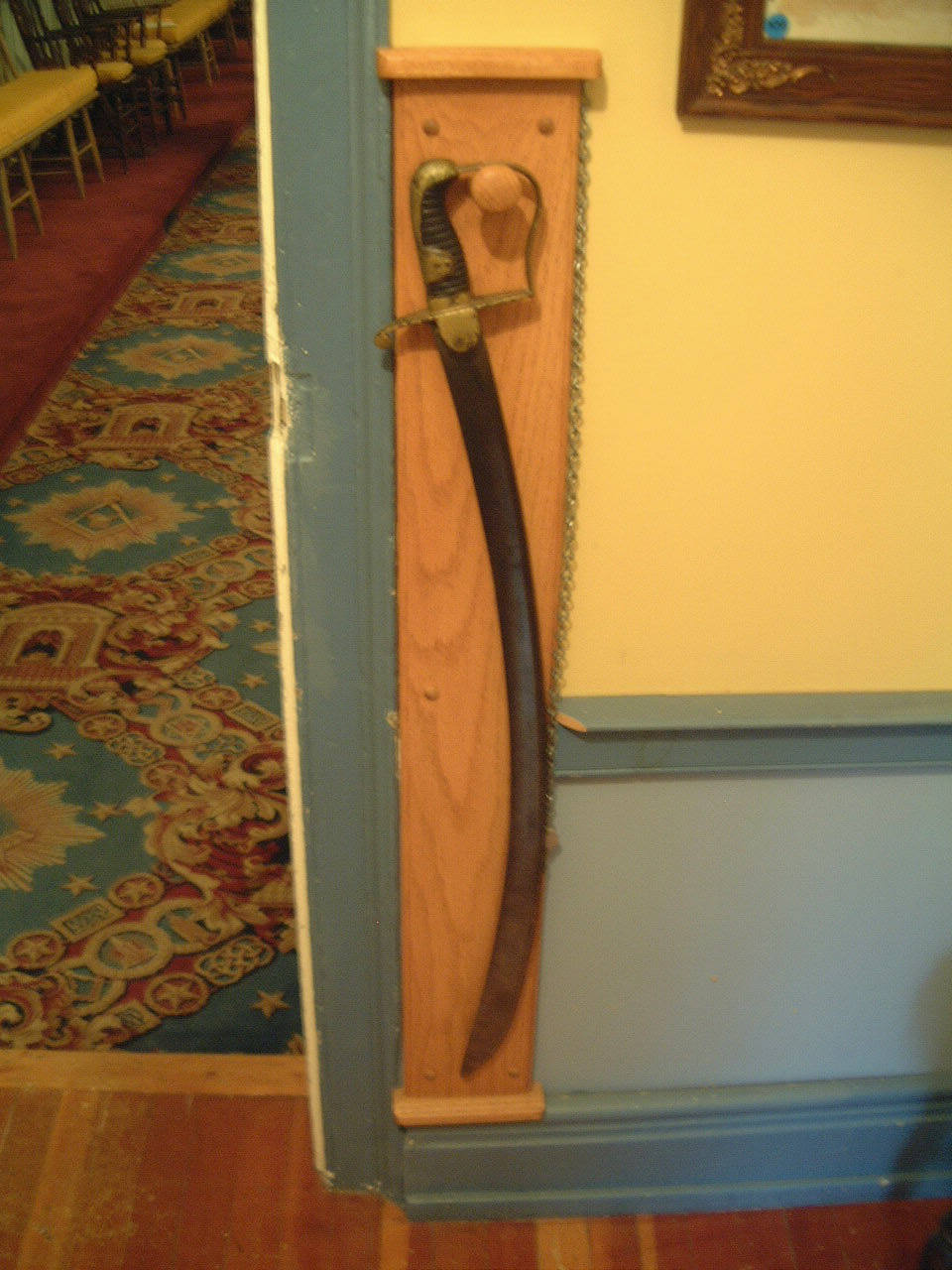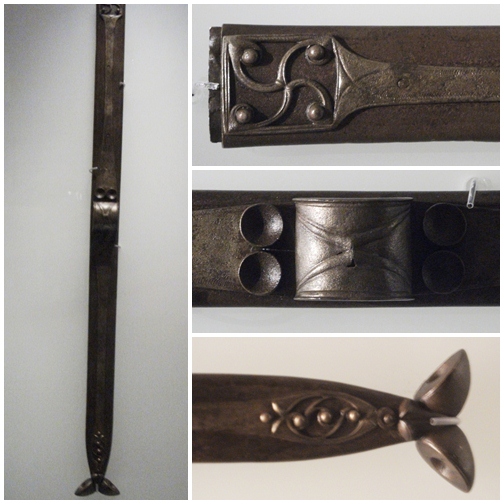|
Szabla Wz.34
Szabla wz. 34 (literally "1934 Pattern Szabla") was the last service sword issued to the Polish cavalry and other mounted units of the Polish Army. One of the finest weapons in a long list of Polish sabres reaching back to the early 16th century, although its introduction occurred as swords finally became obsolete as military weapons, it was successfully used in combat during the 1939 Invasion of Poland and remains in service (as szabla wz. 1934/2002) as a ceremonial weapon. History The Polish cavalry units have been using sabres rather than broadswords at least since the 16th century. In the 18th century Poland ceased to exist as a sovereign nation in the effect of the partitions of Poland, but the Polish sabre, or szabla, remained in use. First as a weapon of various Polish units serving in the armies of other powers, and then its use spread to practically all light cavalry units in Europe and elsewhere. The British Pattern 1796 light cavalry sabre was perhaps the best- ... [...More Info...] [...Related Items...] OR: [Wikipedia] [Google] [Baidu] |
Cavalry
Historically, cavalry (from the French word ''cavalerie'', itself derived from "cheval" meaning "horse") are soldiers or warriors who fight mounted on horseback. Cavalry were the most mobile of the combat arms, operating as light cavalry in the roles of reconnaissance, screening, and skirmishing in many armies, or as heavy cavalry for decisive shock attacks in other armies. An individual soldier in the cavalry is known by a number of designations depending on era and tactics, such as cavalryman, horseman, trooper, cataphract, knight, hussar, uhlan, mamluk, cuirassier, lancer, dragoon, or horse archer. The designation of ''cavalry'' was not usually given to any military forces that used other animals for mounts, such as camels or elephants. Infantry who moved on horseback, but dismounted to fight on foot, were known in the early 17th to the early 18th century as '' dragoons'', a class of mounted infantry which in most armies later evolved into standard cavalry while ... [...More Info...] [...Related Items...] OR: [Wikipedia] [Google] [Baidu] |
Charge (warfare)
A charge is an offensive maneuver in battle in which combatants advance towards their enemy at their best speed in an attempt to engage in a decisive close combat. The charge is the dominant shock attack and has been the key tactic and decisive moment of many battles throughout history. Modern charges usually involve small groups of fireteams equipped with weapons with a high rate of fire and striking against individual defensive positions (such as a concertainer or bunker), instead of large groups of combatants charging another group or a fortified line. Infantry charges Ancient charges It may be assumed that the charge was practiced in prehistoric warfare, but clear evidence only comes with later literate societies. The tactics of the classical Greek phalanx included an ordered approach march, with a final charge to contact. Highland charge In response to the introduction of firearms, Irish and Scottish troops at the end of the 16th century developed a tactic ... [...More Info...] [...Related Items...] OR: [Wikipedia] [Google] [Baidu] |
Pattern 1908 And 1912 Cavalry Swords
The Pattern 1908 cavalry trooper's sword (and the 1912 Pattern, the equivalent for officers) was the last service sword issued to the cavalry of the British Army. It has been called the most effective cavalry sword ever designed, although its introduction occurred as swords finally became obsolete as military weapons. In use, it, like other thrust-based cavalry swords, is best described as a one-handed lance, due to its complete lack of utility for anything but the charge. In fact, the closely related US Model 1913 Cavalry Saber was issued with only a saddle scabbard, as it was not considered to be of much use to a dismounted cavalryman. Colonial troops, who could expect to engage in melee combat with opposing cavalry frequently carried cut and thrust swords either instead of, or in addition to, the P1908/1912. In military circles, there had long been the debate over whether the use of the point or the edge was the better method of attack for a cavalryman. In the Napoleonic peri ... [...More Info...] [...Related Items...] OR: [Wikipedia] [Google] [Baidu] |
Model 1913 Cavalry Saber
The Model 1913 Cavalry Sword, commonly referred to as the Patton Saber, was a cavalry sword designed for the U.S. Army by Second Lieutenant (later General) George S. Patton Jr. in 1913. Patton suggested the revision from a curved sword and edge and cutting technique to a thrusting style of attack, following his extensive training in France. It had a large, basket-shaped hilt mounting a straight, double-edged, thrusting blade designed for use by light cavalry. Although officially designated a saber, it lacks the curved edge typical of many models of saber. This weapon, the last sword issued to U.S. cavalry, was never used as intended. At the beginning of U.S. involvement in World War I, several American cavalry units armed with sabers were sent to the front, but they were held back. The character of war had changed, making horse-mounted troops easy prey for enemy troops equipped with Gewehr 98 rifles and MG08 machine guns. Cavalrymen who saw combat did so dismounted, using their h ... [...More Info...] [...Related Items...] OR: [Wikipedia] [Google] [Baidu] |
Scabbard
A scabbard is a sheath for holding a sword, knife, or other large blade. As well, rifles may be stored in a scabbard by horse riders. Military cavalry and cowboys had scabbards for their saddle ring carbine rifles and Lever action, lever-action rifles on their horses for storage and protection. Scabbards have been made of many materials over the millennia, including leather, wood, and metals such as brass or steel. Most commonly, sword scabbards were worn suspended from a sword belt or shoulder belt called a baldric. Antiquity Wooden scabbards were typically covered in fabric or leather; the leather versions also usually bore metal fittings for added protection and carrying ease. Japanese blades typically have their sharp cutting edge protected by a wooden scabbard called a Japanese sword mountings#Saya, saya. Many scabbards, such as ones the Greeks and Romans used, were small and light. It was designed for holding the sword rather than protecting it. All-metal scabbards were ... [...More Info...] [...Related Items...] OR: [Wikipedia] [Google] [Baidu] |
Broadsword
The basket-hilted sword is a sword type of the early modern era characterised by a basket-shaped guard that protects the hand. The basket hilt is a development of the quillons added to swords' crossguards since the Late Middle Ages. In modern times, this variety of sword is also sometimes referred to as the broadsword. The basket-hilted sword was generally in use as a military sword, in contrast with the rapier, the slim duelling sword worn with civilian dress during the same period, although each did find some use in both military and civilian contexts. A further distinction applied by arms historians and collectors is that a true broadsword possesses a double-edged blade, while similar wide-bladed swords with a single sharpened edge and a thickened back are called backswords. Various forms of basket-hilt were mounted on both broadsword and backsword blades. One of the weapon types in the modern German dueling sport of ("academic fencing") is the basket-hilted . Morphol ... [...More Info...] [...Related Items...] OR: [Wikipedia] [Google] [Baidu] |
Janusz Wielhorski
Janusz () is a masculine Polish given name. It is also the shortened form of January and Januarius. People *Janusz Akermann (born 1957), Polish painter *Janusz Bardach, Polish gulag survivor and physician *Janusz Bielański, Roman Catholic priest *Janusz Bojarski (born 1956), Polish general *Janusz Bokszczanin (1894–1973), Polish Army colonel *Janusz Christa (1934–2008), Polish author of comic books *Janusz Domaniewski (1891–1954), Polish ornithologist *Janusz Gajos, Polish actor *Janusz Gaudyn (1935–1984), Polish physician, writer and poet *Janusz Głowacki (1938–2017), Polish-American author and screenwriter *Janusz Janowski (born 1965), Polish painter, jazz drummer and art theorist *Janusz Kamiński (born 1959), Polish cinematographer and film director *Janusz Korczak (Henryk Goldszmit), Polish-Jewish children's author, pediatrician, and child pedagogist *Janusz Kurtyka (born 1960), Polish historian specializing in the culture and religion of Poland in the 16th and 17t ... [...More Info...] [...Related Items...] OR: [Wikipedia] [Google] [Baidu] |
Huta Ludwików
Huta Ludwików (literally Ludwików Steelworks, often abbreviated SHL) is one of the oldest and best-known Polish metal parts manufacturers. The company is a subsidiary Of Kielce-based Zakłady Wyrobów Metalowych joint-stock company. Huta Ludwików is a major producer of automotive parts, supplying most European automaker. In the past the name of the factory was primarily associated with various types of military equipment produced for the Polish Army, ranging from the wz. 34 sabres and wz. 31 helmet to SHL motorcycles. It was also the main sponsor (and the namesake) of the now-defunct SHL Kielce sports club. History In 1895 Ludwik Starke from Sosnowiec started a new iron foundry in Pstrążnica near Suchedniów. The new factory, since 1899 owned jointly by Starke, Tadeusz Jarmołowicz and Henryk Brunner, entered the markets of the Russian Empire with a variety of cast iron castings, including pots, frying pans, cast iron pipes and machinery parts. As part of the Old-Polish ... [...More Info...] [...Related Items...] OR: [Wikipedia] [Google] [Baidu] |
Kielce
Kielce (, yi, קעלץ, Keltz) is a city in southern Poland, and the capital of the Świętokrzyskie Voivodeship. In 2021, it had 192,468 inhabitants. The city is in the middle of the Świętokrzyskie Mountains (Holy Cross Mountains), on the banks of the Silnica River, in the northern part of the historical Polish province of Lesser Poland. Kielce has a history back over 900 years, and the exact date that it was founded remains unknown. Kielce was once an important centre of limestone mining and the vicinity is famous for its natural resources like copper, lead and iron, which, over the centuries, were exploited on a large scale. There are several fairs and exhibitions held in Kielce throughout the year. The city and its surroundings are also known for their historic architecture, green spaces and recreational areas like the Świętokrzyski National Park. In sports, the city is known as the home of the top-tier handball club, multiple Polish Champion and one-time EHF Champions Le ... [...More Info...] [...Related Items...] OR: [Wikipedia] [Google] [Baidu] |
Instytut Techniczny Uzbrojenia
Military Institute of Armament Technology ( pl, Wojskowy Instytut Techniczny Uzbrojenia; WITU) is a Polish scientific institution responsible for the research and development of new technologies for use by the military. It is based in Zielonka at the outskirts of Warsaw. Subordinate to the Ministry of National Defence, the institute is considered one of "central institutions", that is one of state-owned institutions essential to the functioning of the state. History The institute was founded 25 March 1926 as the Institute for Artillery Research ( pl, Instytut Badań Artylerii). The new institution consisted of three departments dubbed centres: Centre for Field Studies (later renamed to Centre for Ballistic Studies) in Zielonka, Centre for Laboratory Research and the Technical Bureau. In 1935 the institute was renamed to Institute of Armament Technology ( pl, Instytut Techniczny Uzbrojenia; ITU). As one of the principal centres for research and development of weapons, the ITU was resp ... [...More Info...] [...Related Items...] OR: [Wikipedia] [Google] [Baidu] |







